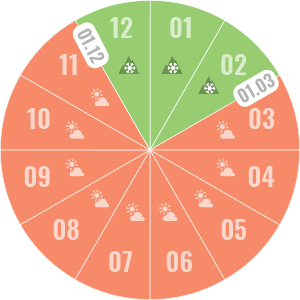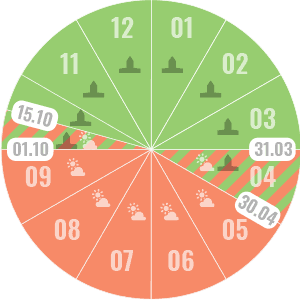When can you use winter tires in Estonia?
When can you use studded tires in Estonia?
How to extend the life of winter tires?
When can you use winter tires in Estonia?
 In Estonia, the use of studless winter tires is mandatory from 1 December to March 1. Only those non-studded winter tires for vehicles that are designed taking into account the climate of the Nordic countries are allowed to be used. Compliant winter tires are marked with the Three Mountain Peaks and Snowflake symbol (3PMSF).
In Estonia, the use of studless winter tires is mandatory from 1 December to March 1. Only those non-studded winter tires for vehicles that are designed taking into account the climate of the Nordic countries are allowed to be used. Compliant winter tires are marked with the Three Mountain Peaks and Snowflake symbol (3PMSF).
However, we advise you to use common sense and the traffic situation. Already from October 15, if the temperature does not rise above +5 degrees, you can safely install winter tires and face any bad weather fully prepared. The same applies to the “closing of the season” date - if in March the weather still presents sudden snowy surprises, then it is better to hold off on switching to summer tires.
As an exception, vehicles using all-terrain tires that comply with UNECE regulation No. 54 and marked with the corresponding professional all-terrain tire symbol “POR” (Professional Off Road) do not have to use tires that bear the symbols with three mountain peaks and a snowflake.
On our website you can conveniently book a date and time for tire replacement.
When can you use studded tires in Estonia?
 The use of studded tires is regulated by the Decree of the Minister of Economic Affairs and Communications dated June 13, 2011 No. 42 “Technical requirements and equipment requirements for a car and its trailer”, Appendix 1, which states: “Studded tires can be used on a car from October 15 to March 31. As an exception in the case of winter roads and weather conditions From October 1 to April 30, you can use studded tires."
The use of studded tires is regulated by the Decree of the Minister of Economic Affairs and Communications dated June 13, 2011 No. 42 “Technical requirements and equipment requirements for a car and its trailer”, Appendix 1, which states: “Studded tires can be used on a car from October 15 to March 31. As an exception in the case of winter roads and weather conditions From October 1 to April 30, you can use studded tires."
Studded tires do not have to meet the requirements for winter tires used in severe snow conditions and therefore do not need to be marked with the Three Peaks and Snowflake symbol (3PMSF). However, leading tire manufacturers have carried out all the tests to confirm the quality of their winter tires. That's why many studded tires have this icon.
Features of winter tires
Since it is legally permitted to use siped tires all year round, it is a completely legal option to install winter sipes once and use them all year round. However, this is an extremely irrational way to use winter tires for a number of reasons.
Winter tires are designed specifically for use in cold weather – at temperatures no higher than +7◦C. Compared to summer tires, winter models do not harden or become deformed in the cold. However, if you drive on such tires in hot weather, their wear will increase and the tires will quickly become unusable.
The chemical composition of winter tires is softer than summer tires, so at low temperatures they do not harden like summer tires, but retain their elasticity, and driving remains safe.
The tread pattern of winter tires is higher (deep) than that of summer tires. Winter tires are also distinguished by dense cutting of lamellas - special grooves on the tread. They drain water, increase traction during snowfall or melting slush, and improve handling. Noise and vehicle contact with the road depend on the tread pattern.
There are two types of tread: European and Scandinavian.

European protector (1)
Thaws and slush in winter are a normal phenomenon in modern Europe. Therefore, the European-type protector was developed for climates with slight frosts and frequent thaws.
European winter tires are distinguished by a shallow tread with a non-aggressive but pronounced pattern. They can be either asymmetrical or symmetrical. The design of the treadmill is designed taking into account the need for effective removal of water and snow slush from the contact patch with the road.
Still, they should not be confused with all-season tires. The rubber composition remains frost-resistant, meaning operation at low air temperatures. This is an ideal option for those regions where snow does not fall too often and thaws are a frequent occurrence.
Scandinavian protector (2)
If heavy snowfalls prevail in the region, snowfalls on the roads are not uncommon, and sometimes you have to move on country roads, even on compacted ones, the Scandinavian tread pattern comes to the rescue.
Its distinctive features are large blocks, deep and wide grooves, sharp edges of the tread zone. Everything is done to ensure that handling and braking on snow and ice remain at a high level. Such tires work well with compacted snow, ice and will not let you down on asphalt.
Often, such tires include special components - multifaceted microparticles that act as spikes on a slippery road.
The tread pattern can be symmetrical or asymmetrical, as well as directional and non-directional. A symmetrical pattern is considered to be universal; its only drawback is noise.
Tire width is one of the main parameters affecting the tendency to slip. The narrower the tires, the better the car's stability on slippery surfaces. In addition, narrow tires accelerate and brake faster on ice.
A full-fledged winter tire must have a residual tread depth of at least 5 mm.
It should be taken into account that the service life of winter tires is from 2 to 4 seasons.
Regardless of which winter tires the car owner chooses, you need to remember simple rules.
- You need to change summer tires on all wheels at once, installing the same type of winter tires.
- You can’t delay replacing tires. As soon as the air temperature drops to plus 5 degrees, you can safely go and change your car to a winter set of tires.
- In winter, you should be more careful on the roads and, if possible, avoid aggressive driving.
- If the car is wearing studded tires, you should be especially careful when driving on bare asphalt; it is recommended to reduce your speed limit.
Running in new winter tires
Any tires also require a certain break-in and this is due to several points:
- The technological process of tire manufacturing involves applying fat-containing lubricants to the matrix during vulcanization. There is only one way to remove them - drive about 150-200 km in a gentle mode without sudden braking and acceleration.
- Not all sipes and grooves will be open on a new tire. Small elements of the tread pattern and sharp edges will also open after a short break-in.
Road conditions in different regions of Estonia can be found on the website tarktee.ee
When purchasing winter tires from the Pit Stop online store, you can easily find and filter tires by season, noise level, and tread pattern.
Features of studded tires
The main purpose of studded tires is to provide the best possible handling and braking in icy and snowy conditions - the purpose of studs is essentially to provide vehicle stability and traction on bare ice. This means that studded tires are best suited for when you do a lot of driving on highways, secondary roads, or during hours when road maintenance vehicles are not yet on duty.
However, in addition to a number of advantages, studded tires also have some disadvantages. Namely, studded tires lead to significantly greater wear of the road surface - metal studs, when driving, are constantly in contact with the road and scratch it, thereby causing more noise. Therefore, for a driver who mainly drives around the city, sipes are a better choice, as they can handle lighter snow and ice well, causing less pollution.
Recently, models of tires with studs have appeared, which, at a certain pressure on them, hide inside the tread. This technology has a number of advantages. The spikes become more protected and are less likely to fly out or wear out. There is no destruction of the road surface. Reduces noise when driving on asphalt. However, when driving on ice, the spikes on such tires do not hide. They also bite into the ice, providing traction, just like regular studs.
You should also consider that winter tires with studs will always be noisier than sipes, and that noise levels vary by manufacturer and model.
Rules for running in new tires with studs
It is recommended to run in new studded tires for the first 100-200 km. To break in new winter tires, manufacturers advise driving several hundred kilometers at a speed of no more than 70 km/h. In this case, the driver should avoid sudden accelerations, cornering at high speed and sudden braking.
In our online store you can conveniently filter only tires with studs.
How to extend the life of winter tires?
There are several tips on how to extend the life of your tires.
Check your tire pressure regularly
Both excess and insufficient pressure are harmful. In the first case, the center of the tire wears out faster, and with insufficient pressure, the “shoulders” of the tires are the first to suffer. In general, it is believed that if the pressure is 0.3-0.4 bar or atmosphere less than normal, then the tire service life is reduced by 20-25%. But it is impossible to determine by eye a pressure drop of 0.3 bar. Therefore, the pressure should be checked at least once a month. The pressure must comply with the car manufacturer's recommendations, which can be found in the vehicle manual or on the insert-table on the gas filler flap or in the driver's door arch. And an important note - you need to check the tire pressure in winter outside, not indoors.
Change tires
Every 7-10 thousand km, change the tires: put the front ones back and vice versa. In this case, tire wear will be even.
Don't accelerate
Aggressive driving style with sudden starts and braking seriously reduces tire life. This advice is especially relevant for studded tires. If you drive quietly, your tires will last much longer. And do not neglect the rules of running in studded tires, this will significantly extend their service life.
Check for even wear
Have you noticed that the tread on your tires is wearing unevenly? Be sure to check the wheel alignment and balance the wheels. During operation, suspension parts wear out, and this leads to a violation of the wheel alignment angles. If you frequently fall into holes, the balancing weights are lost.
On our website you can book a time convenient for you to undergo a wheel alignment check
